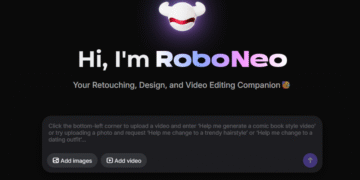In the rapidly evolving landscape of AI-generated content (AIGC), Kling AI, developed by Chinese technology powerhouse Kuaishou, has rapidly emerged as a significant player, officially launching in June 2024. Positioned not just as a new tool but as the “new infrastructure for video creation in the AI era,” Kling AI is a strategic initiative by Kuaishou, a dominant force in the short-video sector. Its core mission is to “empower everyone to tell great stories with AI,” enabling precise and complex creative expression through imaginative and realistic video and image generation from text and image prompts.
Kling AI’s aggressive development cycle is noteworthy, with over 20 iterations and major versions (1.5, 1.6, 2.0, 2.1) released between December 2024 and June 2025. This rapid pace underscores Kuaishou’s commitment to achieving and maintaining a competitive edge, likely catalyzed by high-quality benchmarks set by rivals like OpenAI’s Sora. Kuaishou’s strategy emphasizes “foundational supremacy,” prioritizing enhancements to the core model’s quality, such as “motion quality, semantic responsiveness, and visual aesthetics,” rather than a wide array of peripheral features. This focus on perfecting the core engine’s ability to simulate a realistic world is considered the most difficult technical challenge and thus, a defensible competitive moat. Within a year, Kling AI garnered over 22 million global users and onboarded more than 10,000 API clients, demonstrating substantial early market traction.
Technical Architecture and Core Capabilities: The Engine Behind Realism
Kling AI’s impressive performance is rooted in a sophisticated and proprietary technical architecture designed to overcome the core challenges of video generation, particularly the maintenance of temporal and spatial consistency.
The Core Engine: Diffusion Transformer (DiT) and 3D VAE At the heart of Kling AI lies a Diffusion Transformer (DiT) architecture. This critical design choice replaces the U-Net backbone common in earlier diffusion models with a Transformer. Transformers are inherently more effective at capturing long-range dependencies and global context within data, which is essential for understanding the complex relationships between frames in a video sequence.
However, Kling’s most significant innovation is Kuaishou’s self-developed 3D Variational Autoencoder (VAE). While a standard 2D VAE processes each video frame independently, often leading to flickering and a lack of object permanence, Kling’s 3D VAE addresses this by compressing video data across three dimensions simultaneously: width, height, and time. It treats a video clip as a holistic “3D spacetime” block rather than a series of individual images. This synchronous spatiotemporal compression is fundamental to the model’s ability to maintain consistency over time and avoid common artifacts.
This core architecture is further enhanced by a 3D spatiotemporal joint attention mechanism. This mechanism allows the model to analyze spatial features within each frame while simultaneously tracking their dynamic evolution across frames. This comprehensive processing enables Kling to model complex, physically plausible motions with a high degree of realism and maintain the consistency of characters and objects throughout a scene. The architecture is explicitly designed to simulate real-world physics, accounting for factors like gravity, light, and shadow, which further grounds the generated content in reality.
Model Evolution and Versioning Kling’s rapid iteration has led to a tiered system of models, each with distinct capabilities:
• Kling 1.5/1.6: These versions introduced 1080p HD video generation, a dedicated high-quality mode, and more natural motion rendering. Kling 1.6 Pro notably offered superior video quality and unique features like “last frame conditioning,” allowing users to specify both the start and end states of a video for seamless transitions or loops. These models are best for quick concepts and prototyping.
• Kling 2.0: Marketed as a paradigm shift, this version introduced the “MVL” (Multi-modal-document as a Word) concept to redefine human-AI interaction. It delivered major improvements in prompt adherence and cinematic quality. Its flagship feature was the introduction of multimodal editing, allowing users to provide images and other inputs to fine-tune generated content with greater precision. Kuaishou’s internal benchmarks claimed Kling 2.0 significantly outperformed rivals like Google’s Veo and Runway’s Gen-4 in semantic responsiveness and visual quality, making it best for filmic quality and natural camera work.
• Kling 2.1: This release refined the 2.0 foundation, bringing improved action control, better character consistency, more sophisticated camera framing tools, and faster generation speeds. It also introduced the premium “Master” variant, designed for high-end, cinematic video generation with the highest levels of prompt adherence and dynamic quality.
• Kolors Model: Powering many of Kling’s image-based features, the parallel development of the Kolors image generation model, particularly Kolors 2.0, underpins Kling’s image-to-video and advanced image editing functionalities.
Key Generative Features and Specifications Kling offers a robust suite of features designed to provide creators with a high degree of control:
• Core Generation Modes: The platform’s primary functions are Text-to-Video and Image-to-Video generation.
• Multimodal Editing: A key differentiator with Kling 2.0, this allows users to provide multimodal inputs (e.g., reference images) to directly guide the AI on complex creative elements like character identity, style, actions, camera movements, and scenarios.
• Video Extension: Crucial for longer content, users can extend generated clips up to three minutes in total length.
• Advanced Controls: Includes a “Motion Brush” for directing specific object movement, an “Elements” feature for character/style consistency using reference images, and an enhanced lip-sync function with Text-to-Speech (TTS) voiceover capabilities.
• Performance Specifications:
◦ Resolution: Capable of generating video up to 1080p HD (1920×1080).
◦ Duration: Initial clips are 5 or 10 seconds, extendable up to two to three minutes.
◦ Frame Rate: Supports standard frame rates of 24 and 30 fps.
◦ Aspect Ratios: Offers flexibility with support for multiple aspect ratios, including square (1:1), widescreen (16:9), and vertical (9:16).
The Competitive Landscape: Kling AI vs. The Titans
Kling AI has entered a highly competitive and rapidly advancing market, positioning itself against leading platforms in generative video.
Kling vs. OpenAI’s Sora The comparison with Sora is critical, as Sora set the current industry quality benchmark:
• Quality and Realism: Kling demonstrates the ability to produce cinematic-quality videos with lifelike motion that are highly competitive with, and in some user tests, superior to Sora’s outputs. Kling’s strength is its simulation of real-world physics and coherent character motion. Sora is known for imaginative and complex scenes but can exhibit issues with object permanence and unnatural movements.
• Accessibility and Cost: This is Kling’s most significant competitive advantage. Kling is publicly accessible worldwide via email registration, whereas Sora remains in limited access. Sora is also expected to be substantially more expensive than Kling.
• Features: Kling offers longer potential video duration (up to three minutes compared to Sora’s typical one-minute limit) and granular control features like Motion Brush. Sora’s advantages include deep language understanding for nuanced prompt interpretation and the ability to generate multiple distinct shots within a single generation while maintaining character consistency.
Kling vs. Runway Runway is a different type of competitor, positioning itself as a comprehensive creative suite:
• Target Audience and Feature Set: Runway targets professional creators with a broad suite of AI-powered tools beyond video generation (editing, image manipulation, collaboration). Kling focuses on achieving the highest fidelity in core generation capabilities.
• Quality and Speed: Kling is often perceived as having superior character animation and better prompt adherence. Runway’s key advantage is its significantly faster generation speed, making it suitable for rapid prototyping. However, Runway’s output can sometimes exhibit more AI artifacts or a “game-like” aesthetic compared to Kling’s cinematic realism.
• Control: Both allow camera control via text prompts. Runway offers more “tweaking” options, while Kling excels at interpreting specific requests for frame composition and leading lines.
Kling vs. Luma AI’s Dream Machine Dream Machine competes primarily on speed, accessibility, and motion quality:
• Motion and Coherence: Both are strong in fluid motion. However, comparative tests suggest Kling produces more convincing and less distorted character animation, especially for complex actions. Luma’s outputs can suffer from “decoherence” and “morphing” artifacts. Luma is praised for seamless clip extension and its “Enhanced Prompt” feature for complex prompts.
• User Experience: Luma is cited for speed and simple, natural language prompting, making it highly accessible, though its UI can be less intuitive. Kling’s free tier can have extremely long generation queues.
• Stylistic Capabilities: Kling tends to render anime-style prompts realistically, while Luma has shown an ability to produce impressive and stylistically consistent anime loops.
Strategic Positioning Summary
• Developer: Kuaishou Technology.
• Public Access: Yes (Worldwide).
• Max Video Length: ~3 minutes (extended).
• Core Strength: Physics & Motion Simulation.
• Key Differentiator: 3D VAE, Multimodal Editing.
• Target Audience: Prosumers, Marketers.
• Pricing Model: Freemium, Subscription/Credits.
Product Ecosystem, User Experience, and Monetization
Despite Kling AI’s impressive underlying technology, its success as a product is significantly impacted by its accessibility, usability, and business model, revealing a dichotomy between technical prowess and user experience.
Platform Accessibility Kuaishou has pursued a multi-pronged strategy for platform access:
• Initially launched with a restrictive, China-only beta requiring a Chinese phone number, Kling has since rolled out a global version accessible at klingai.com with standard email registration.
• Web Portal: The main access point for global users.
• Mobile Application: A dedicated Android app, “Kling AI: AI Image&Video Maker,” is available on Google Play Store.
• API Access: Kling provides an API, integrated by over 10,000 clients, indicating a strong push into the developer and enterprise ecosystem.
• Additionally, Kling’s models are available through third-party aggregator platforms like Pollo AI and Freepik, increasing reach but risking commoditization.
User Sentiment and Community Feedback User feedback reveals a powerful but flawed product:
• Points of Praise: Users consistently laud the high quality of the generated video, especially the realism and fluidity of motion, convincing character animation, and ability to convey emotion. The image-to-video function is frequently highlighted as a standout feature.
• Points of Criticism: Praise for the output is often tempered by significant frustration with the product experience:
◦ Cost and Credit System: This is the most common complaint. Users describe pricing as steep and the credit-based system as punitive, consuming credits regardless of successful or usable generation. Unpredictability of output makes the cost feel exorbitant.
◦ Platform Instability and Bugs: The application is described as needing to “mature”. Users report slowness, bugs, and videos getting stuck at 99% completion, wasting time and credits.
◦ Lack of Customer Support: Multiple users report unanswered emails for billing or technical problems, a major issue for a paid service.
◦ Perceived Model Degradation: Some long-term users voice concerns that recent updates (e.g., to version 2.1) have resulted in a decline in quality, with outputs becoming more “robotic” and less cinematic.
This contrast highlights a strategic challenge: Kuaishou excels in deep-tech R&D but struggles with building and managing a global, user-friendly, and fairly-priced SaaS product. Issues like opaque pricing, instability, and poor support are classic pitfalls for companies transitioning business models, a vulnerability competitors could exploit.
Monetization and Business Model Kling employs a freemium model. New users receive free daily credits (e.g., 66 upon signup) to test the platform. The primary revenue stream is from paid monthly or annual subscriptions, providing larger credit allotments. However, this model’s success is undermined by user frustrations. The high cost per generation combined with unpredictable output creates a poor value proposition. For sustainability, Kuaishou needs to address output consistency or revise the credit system to be more forgiving of failed generations.
Limitations, Weaknesses, and Common Artifacts
Despite its advanced capabilities, Kling AI has significant limitations and weaknesses critical for any creator or organization to understand.
Generation Constraints and Workflow Hurdles
• Limited Video Length: The most significant constraint is the short duration of each generated clip, typically 5 or 10 seconds. While extensions are possible, stitching multiple segments is cumbersome, time-consuming, and a frequent source of inconsistency.
• Slow Processing Times: Kling is consistently reported to be slower than many competitors. Generation times range from 5 to 10 minutes for subscribers and several hours for free plan users during peak times, severely hampering creative iteration.
• Limited Direct Control: While prompt understanding is strong, Kling lacks direct, granular controls for many parameters. Camera movements, for example, are text-prompt controlled rather than via sliders or keyframes, leading to less precision and more trial and error.
Stylistic and Motion Deficiencies
• Struggles with Complex Motion: The model’s physics simulation, while generally impressive, can break down with highly complex, fast-paced, or intricate movements. Actions like rapid transformations or detailed hand gestures can result in distorted, incomplete, or unnatural-looking animations.
• Stylistic Biases: Kling exhibits a strong bias towards photorealism, making it less effective for certain artistic styles. It particularly struggles with anime, often producing flickering, oversaturated colors, or “morphing” animated characters into realistic people.
Common Visual Flaws and Artifacts Even in successful generations, users can encounter visual flaws:
• Flickering and Detail Instability: Noticeable flickering can occur, especially in fine details like eyes, textures, or consistent color areas.
• Morphing and Distortion: Objects and characters, particularly at frame edges or during complex movements, can unnaturally morph, warp, or blend into the background.
• Random Scene Switches: The model can occasionally lose narrative focus, especially with long or complex prompts, and abruptly switch to a different scene mid-generation. This issue, reported in about one out of ten attempts, wastes time and credits.
Applications and Industry Impact
Kling AI’s capabilities position it as a transformative tool with the potential to impact numerous industries by automating and democratizing video production.
Cross-Industry Use Cases The platform’s ability to quickly generate high-quality video from text or images makes it suitable for a wide array of professional applications:
• Marketing and Advertising: Brands can rapidly prototype and produce engaging ads, social media campaigns, and product demonstration videos, saving costs and time. The “Elements” feature supports this by allowing inclusion of specific product images.
• Social Media and Content Creation: Influencers and digital creators can quickly convert ideas into visually compelling short-form videos for platforms like TikTok and Instagram, potentially boosting engagement.
• Education and E-Learning: Educators can transform static lesson plans or complex concepts into animated, visual learning experiences, making content more engaging and accessible.
• Entertainment and Storytelling: The platform is being explored for pre-visualization, animated storyboards, and even generating final footage for short films and other narrative projects.
Proof of Concept: “Loading the New World” To showcase its narrative potential, Kuaishou co-produced “Loading the New World,” the world’s first anthology series created using AI, which premiered in June 2025. Positioned as a generative AI-era equivalent to Netflix’s “Love, Death & Robots,” the project featured standalone episodes spanning genres from science fiction to comedy, rendered in styles from cyberpunk to photorealistic 3D animation.
This ambitious project served as a powerful proof-of-concept for long-form narrative content. However, observations from the premiere revealed the technology’s current limitations. Critics noted persistent issues such as “inconsistent character portrayal and vague emotional expression“. This highlights a critical distinction: the model can generate visually impressive shots but struggles to construct a coherent, emotionally resonant story. The head of product for Kling acknowledged that the technology is still in an early stage, facing challenges with stability, motion rendering, and clarity, and that achieving desired effects requires significant human effort in rewriting and adjusting prompts.
This reveals the “last mile” problem in AI storytelling: the model excels at simulating scene physics (the “first 90%”) but struggles with the subtle continuity of character identity, motivation, and emotion (the “last 10%”). While it understands the physics of an action, it doesn’t grasp its narrative or emotional weight. This underscores AI’s current role as a powerful yet demanding tool, requiring human creators to meticulously guide, edit, and assemble AI output to bridge this narrative gap. The mission to “empower everyone to tell great stories” remains an aspiration, as the technology currently empowers those with professional skill and patience to manage its shortcomings.
Ethical, Legal, and Policy Analysis: The “Trust Deficit”
Beyond its technical capabilities, Kling AI’s viability and acceptance, particularly in Western markets, are profoundly affected by a complex web of ethical, legal, and policy considerations, creating a significant “trust deficit” that may hinder widespread professional and enterprise adoption.
Content Moderation and Geopolitical Censorship Kling operates under a dual system of content moderation, reflecting both standard platform safety concerns and the specific regulatory environment of China:
• Standard Community Guidelines: Kling prohibits content broadly considered harmful, such as material promoting terrorism, inciting violence, or containing racial or gender discrimination. It also has a built-in NSFW filter and does not officially permit sexually explicit content.
• Political Censorship: A more contentious aspect is the active censorship of politically sensitive topics, a direct result of Chinese government pressure. The Cyberspace Administration of China (CAC) requires AI models to align with state-sanctioned values. Consequently, Kling systematically blocks prompts related to “Democracy in China,” “Xi Jinping,” “Tiananmen Square protests,” and other politically charged subjects, returning a “generation failed” error. This is enforced via keyword filtering, real-time content analysis, and curated training datasets.
• User Backlash and Unpredictability: This heavy-handed and often inconsistent censorship is a major source of user frustration. Creators report even safe-for-work content can be arbitrarily blocked, rendering the platform unreliable. This unpredictability is a significant risk for professional users, where campaigns could be derailed by opaque, politically motivated moderation.
Copyright and Intellectual Property IP policies on Kling present another major concern for users:
• Ownership of Generated Content: The legal status of AI-generated works is a global gray area. U.S. Copyright Office guidance suggests works created by AI without substantial human input are not eligible for copyright. This creates a precarious situation, as creators may be unable to legally protect their final videos from being copied. While Kling’s Payment Policy grants commercial use rights for paid outputs, this does not equate to copyright ownership.
• License Grant for User Content: The most alarming clause is in Kling’s Terms of Service. By using the platform, users grant Kuaishou a broad, worldwide, irrevocable, perpetual, royalty-free, and sublicensable license to any uploaded content, including source images and prompts. This means Kuaishou can use, modify, and distribute a user’s proprietary data in almost any way, even after service cessation. This presents an unacceptable IP risk for enterprises using the platform for product demos or marketing with proprietary designs or confidential information.
Deepfakes, Misinformation, and Security As a powerful video generation tool, Kling has inherent potential for misuse in creating deepfakes and spreading misinformation:
• Deepfake Potential: The platform’s advanced 3D face and body reconstruction technology makes it highly capable of creating realistic digital replicas. While Kling policies mention filtering for “misinformation,” there is no specific, publicly available policy addressing deepfakes. This lack of clarity is concerning, given increasing legislative scrutiny of deceptive AI-generated media.
• Security Risks: Kling’s popularity has made it a target for malicious actors. A documented cyberattack campaign involved fake Kling AI advertisements on social media luring users to fraudulent websites that distributed Remote Access Trojans (RAT), malware giving attackers control over victims’ computers. While not a flaw in Kling’s own security, such campaigns damage the brand’s reputation and erode user trust.
The combination of unpredictable censorship, significant IP risks, and potential for misuse creates a substantial trust deficit. For Western enterprises prioritizing legal certainty, IP protection, and predictable workflows, these issues represent a greater barrier to adoption than any technical limitations.
Conclusion: Strategic Outlook and Future Trajectory
Kling AI represents a paradox: a triumph of technological innovation encumbered by significant strategic liabilities. Its core engine for simulating motion and physics is undeniably world-class, positioning Kuaishou as a leader in foundational generative video technology. However, its path to sustained global success is far from certain, as its future depends as much on resolving product and policy challenges as on technical advancements.
Summary of Strategic Position Kling’s primary strength is its sophisticated technical architecture, particularly its proprietary 3D VAE, delivering superior temporal consistency and physically plausible motion. This focus on foundational quality and an aggressive iteration cycle allows it to compete at the highest level of the AIGC market. However, this strength is offset by critical weaknesses. The platform suffers from a poor user experience, characterized by a punitive pricing model, slow performance, and lack of support. More importantly, it is burdened by a profound trust deficit stemming from opaque, politically influenced censorship policies and user-unfriendly IP terms. These factors make it a volatile and high-risk choice for the professional and enterprise markets it seeks to capture.
Future Roadmap and Innovations Kuaishou’s ambitions for Kling extend beyond current capabilities. The publication of the “Kling-Foley” research paper on multimodal video-to-audio generation signals a strategic goal to evolve Kling into a comprehensive “AI scene generator,” capable of synthesizing high-quality, synchronized audio (sound effects, speech, music) directly from video. This would represent a significant leap forward and a powerful competitive differentiator. Based on past release cadence, users can expect continued improvements to the core model, likely focusing on enhancing character consistency, increasing base generation length, and eventually offering higher resolutions such as 4K.
Final Recommendations for Stakeholders
• For Creative Professionals: Kling AI is a potent but unpredictable tool, best utilized for generating high-quality, motion-rich B-roll or specific shots within a larger, human-supervised workflow. Professionals should be wary of the credit system’s cost and prepared for significant trial-and-error. Using Kling through a third-party aggregator like Freepik or Pollo AI may offer better cost control and access to multiple models.
• For Enterprise Adopters: In its current state, the platform presents substantial intellectual property and operational risks. The terms of service regarding user data and the unpredictability of its censorship filters make it unsuitable for most business-critical applications. Any potential adoption requires thorough legal review. Competitors like Runway, built with professional workflows and clearer IP terms, may offer a more stable and legally secure alternative.
• For Investors and Market Analysts: Kuaishou’s investment in Kling is a technologically impressive and strategically serious bid for leadership in the AIGC sector, with its core technology being a significant asset. However, its potential for global market penetration is heavily contingent on its ability to overcome the trust deficit. The key dynamic to watch is whether Kuaishou can or will reform its product policies and user agreements to align with Western enterprise customer expectations, a challenge that may prove as difficult as any technical hurdle. Kling AI’s journey will serve as a crucial case study on whether superior technology from China can transcend geopolitical and policy barriers in the current global landscape.










